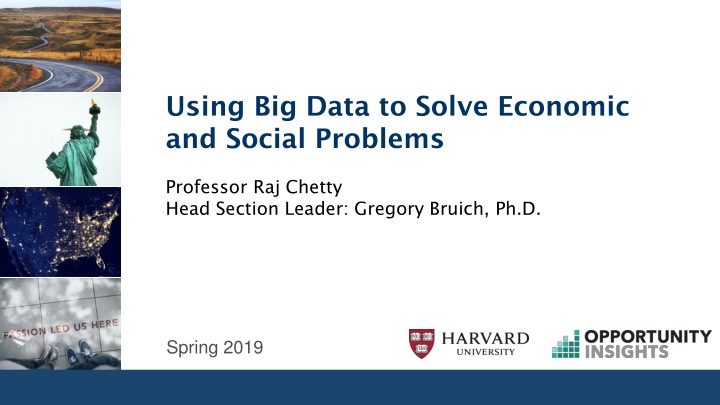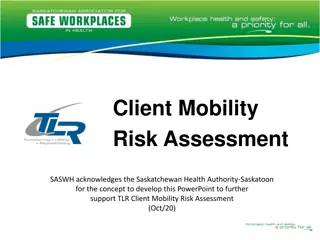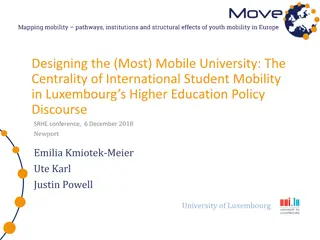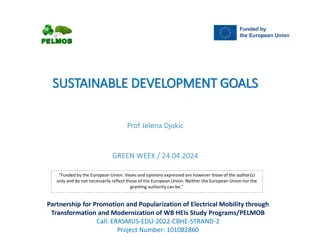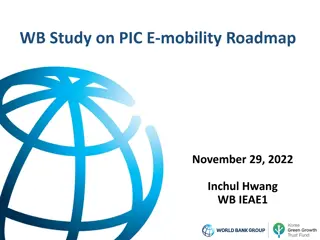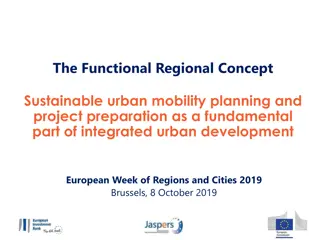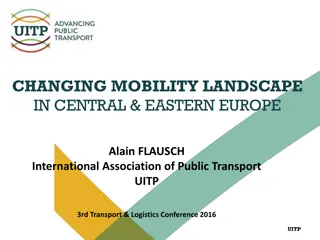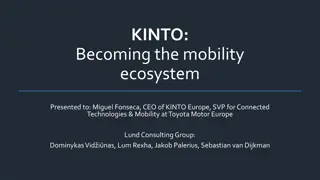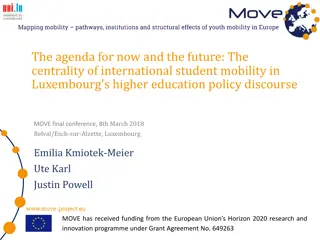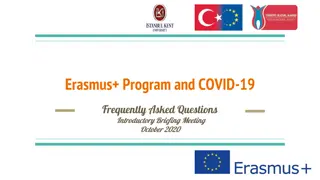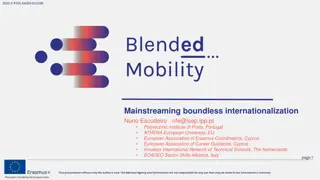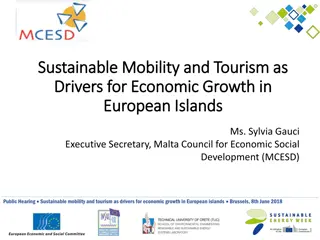Enhancing Economic Mobility Through Education: A Data-Driven Approach
Education is a crucial pathway to economic mobility in the U.S., but challenges such as unequal school quality, rising college costs, and disparities in college attendance persist. By leveraging big data and analyzing impacts systematically, solutions can be devised to address these issues and improve opportunities for upward mobility. Understanding the role of colleges in shaping income mobility is essential, considering factors like parental income distributions, student outcomes, and colleges' causal effects on mobility.
Download Presentation

Please find below an Image/Link to download the presentation.
The content on the website is provided AS IS for your information and personal use only. It may not be sold, licensed, or shared on other websites without obtaining consent from the author.If you encounter any issues during the download, it is possible that the publisher has removed the file from their server.
You are allowed to download the files provided on this website for personal or commercial use, subject to the condition that they are used lawfully. All files are the property of their respective owners.
The content on the website is provided AS IS for your information and personal use only. It may not be sold, licensed, or shared on other websites without obtaining consent from the author.
E N D
Presentation Transcript
Using Big Data to Solve Economic and Social Problems Professor Raj Chetty Head Section Leader: Gregory Bruich, Ph.D. Spring 2019
Part II Education
Education and Upward Mobility Education is widely viewed as one of the most scalable pathways to upward mobility But there is growing concern that education no longer provides a strong pathway to opportunity in the U.S. U.S. students perform worse on standardized tests on average than in many European countries despite higher spending on schools Sharp differences in quality of schools across districts Rising costs of college lack of access for low-income students Concern that some colleges (e.g., for-profit institutions) may not produce good outcomes
Education and Upward Mobility How can we improve education in America? Traditionally, measuring impacts of education systematically was difficult Administrative data from colleges and school districts are giving us a more scientific understanding of the education production function Start with higher education, then turn to K-12 education Reference:Chetty, Friedman, Saez, Turner, Yagan. Mobility Report Cards: The Role of Colleges in Intergenerational Mobility Working Paper 2017
How Do Colleges Shape Income Mobility in the U.S.? How does the higher education system affect intergenerational income mobility in the U.S.? In principle, higher education can provide a pathway to upward mobility that is not directly shaped by the neighborhood where a child happens to grow up But if children from higher-income families tend to attend better colleges, higher education system may not promote mobility Colleges could actually increase intergenerational persistence of income if disparities in college attendance are sufficiently large
Effect of Higher Education System on Mobility Effect of higher education system on mobility depends upon three factors: 1. [Inputs] Parental income distributions by college 2. [Outputs] Students earnings outcomes conditional on parental income by college 3. [Causal share] Portion of variation in students earnings outcomes that is due to colleges causal effects
Estimating the Three Parameters: Data Chetty et al. (2017) estimate these three parameters using data covering all college students in the U.S. from 1999-2013 (30 million students) Combine information from three sources to construct an anonymized dataset: 1. Parental and Student Income from income tax records 2. College attendance from 1098-T tax data and Pell grant data 3. SAT scores from College Board Note: all statistics are based on college attendance (not completion)
Parents Income Distributions by College: Income Segregation in the American Higher Education System
Measuring Parents Incomes Parent income: average pre-tax household income during five year period when child is aged 15-19 Focus on percentile ranks, ranking parents relative to other parents with children in same birth cohort
Parent Household Income Distribution For Parents with Children in 1980 Birth Cohort 20th Percentile = $25k Median = $60k 60th Percentile = $74k 80th Percentile = $111k Density 99th Percentile = $512k 0 100000 200000 300000 400000 500000 Parents' Annual Household Income when Child is Age 15-19 ($)
College Attendance Rates vs. Parent Income Percentile 100 80 Percentage in College 60 40 20 0 0 20 40 60 80 100 Parent Rank
Parent Income Distribution at Harvard Classes of 2002-2004 80 70.3% 60 Percent of Students 40 20 13.2% 8.1% 5.3% 3.0% 0 1 2 3 4 5 Parent Income Quintile
Parent Income Distribution at Harvard Classes of 2002-2004 80 70.3% 60 Percent of Students 40 Top 1% 15.4% 20 13.2% 8.1% 5.3% 3.0% 0 1 2 3 4 5 Parent Income Quintile
Parent Income Distribution at Harvard Classes of 2002-2004 80 70.3% 60 Percent of Students Probability of attending Harvard is 103 times higher for children from the top 1% compared to the bottom 20% 40 Top 1% 15.4% 20 13.2% 8.1% 5.3% 3.0% 0 1 2 3 4 5 Parent Income Quintile
Parental Income Distribution of Students at Highly Selective Colleges Percent of Students 0 20 40 60 80 100 Bottom Quintile 2nd Quintile 3rd Quintile Stanford 4th Quintile Top Quintile Top 1% Harvard Yale Princeton MIT Cal Tech Amherst Swarthmore
Parent Income Distribution by Percentile Ivy Plus Colleges (Ivy League plus Stanford, MIT, Duke, and Chicago) 15 14.5% of students from top 1% Percent of Students 10 5 3.8% of students from bottom 20% 0 0 20 40 60 80 100 Parent Rank
Parent Income Distributions by Quintile for 1980-82 Birth Cohorts At Selected Colleges 80 Harvard University 60 Percent of Students 40 20 0 1 2 3 4 5 Parent Income Quintile
Parent Income Distributions by Quintile for 1980-82 Birth Cohorts At Selected Colleges 80 Harvard University UC Berkeley 60 Percent of Students 40 20 0 1 2 3 4 5 Parent Income Quintile
Parent Income Distributions by Quintile for 1980-82 Birth Cohorts At Selected Colleges 80 Harvard University UC Berkeley SUNY-Stony Brook 60 Percent of Students 40 20 0 1 2 3 4 5 Parent Income Quintile
Parent Income Distributions by Quintile for 1980-82 Birth Cohorts At Selected Colleges 80 Harvard University UC Berkeley SUNY-Stony Brook Glendale Community College 60 Percent of Students 40 20 0 1 2 3 4 5 Parent Income Quintile
Parental Income Segregation Across Colleges Sharp differences in parental income distributions across colleges there is significant segregation across colleges Useful benchmark to quantify magnitude: compare to degree of segregation across neighborhoods Common perception: colleges foster greater interaction between children from different socioeconomic backgrounds than places in which they grew up
Parental Income Distribution of Peers of Children from Bottom Quintile 30 Share of Peers (%) 20 10 0 1 2 3 4 5 Peers' Parent Income Quintile Pre-College Neighborhoods (ZIP Codes) Colleges
Parental Income Distribution of Peers of Children from Top Quintile 40 30 Share of Peers (%) 20 10 0 1 2 3 4 5 Peers' Parent Income Quintile Pre-College Neighborhoods (ZIP Codes) Colleges
Parental Income Distribution of Peers of Ivy-Plus College Students from Top Quintile 80 60 Share of Peers (%) 40 20 0 1 2 3 4 5 Peers' Parent Income Quintile Pre-College Neighborhoods (ZIP Codes) Colleges
Trends in Income Segregation Preceding estimates are based on children born between 1980-82, who attended college in the early 2000s Substantial changes in higher education system since that time, e.g. substantial changes in financial aid and tuition policies How has income segregation across colleges changed in recent years?
Fraction of Peers from the Top Quintile for Children from the Top Quintile 40 30 Percent 20 10 0 2000-02 2003-05 Year when the child was 20 Parent income segregation across pre-college residential ZIP codes Parent income segregation across colleges 2006-08 2009-11
Trends in Low-Income Access from 2000-2011 at Selected Colleges 40 Percent of Parents in the Bottom Quintile 35 30 25 20 15 10 5 0 2000 2002 2004 Year When Child was 20 Stanford 2006 2008 2010 Harvard
Trends in Low-Income Access from 2000-2011 at Selected Colleges 40 Percent of Parents in the Bottom Quintile 35 30 25 20 15 10 5 0 2000 2002 2004 Year When Child was 20 Stanford 2006 2008 2010 Harvard UC Berkeley SUNY Stony Brook Glendale CC
Students Earnings Outcomes Measure children s individual earnings in their mid-30s Define percentile ranks by ranking children relative to others in same birth cohort
Distribution of Childrens Individual Labor Earnings at Age 34 1980 Birth Cohort p20 = $ 1k p50 = $28k p80 = $58k p99 = $197k Density 0 50000 100000 150000 Individual Earnings ($)
Students Earnings Outcomes Columbia vs. SUNY-Stony Brook 80 Columbia SUNY-Stony Brook 60 Percent of Students 40 20 0 1 2 3 4 5 Parent Income Quintile
Students Earnings Outcomes Key lesson: most of the gap in outcomes between children from low vs. high- income families is explained by differences betweenrather than withincolleges Raises possibility that reallocating student across colleges could potentially have a significant impact on intergenerational mobility If gap in outcomes by parental income were large even within a given college, there would be little scope to have an impact through changes in college admissions policies
Differences in Mobility Rates Across Colleges We can combine data on parents incomes and students outcomes to characterize colleges mobility rates At which colleges in America do the largest number of children come from poor families and end up in the upper middle class?
Students Earnings Outcomes Columbia vs. SUNY-Stony Brook 80 Columbia SUNY-Stony Brook 60 Percent of Students Top-Quintile Outcome Rate: Fraction of Students who Reach Top Quintile = 51% 40 Fraction of Parents from Bottom Quintile (<$25K) = 16% 20 0 1 2 3 4 5 Parent Income Quintile
Measuring Mobility Rates Define a college s mobility rate (MR) as the fraction of its students who come from bottom quintile and end up in top quintile Mobility rate is: Mobility Rate = Low-Inc. Access x Top-Quintile Rate At SUNY: 8.4% = 16% x 51% Frac. of Parents in Q1 and Children in Q5 Frac. of Frac. of Students Parents in Q1 who reach Q5 Given Parents in Q1
Mobility Rates: Top-Quintile Outcome Rate vs. Access by College Top-Quintile Outcome Rate: P(Child in Q5 | Par in Q1) 100 80 60 Columbia SUNY-Stony Brook 40 20 0 0 20 40 60 Access: Percent of Parents in Bottom Quintile
Mobility Rates: Top-Quintile Outcome Rate vs. Access by College Top-Quintile Outcome Rate: P(Child in Q5 | Par in Q1) 100 80 60 Columbia SUNY-Stony Brook 40 20 0 0 20 40 60 Access: Percent of Parents in Bottom Quintile
Mobility Rates: Top-Quintile Outcome Rate vs. Access by College Top-Quintile Outcome Rate: P(Child in Q5 | Par in Q1) 100 80 Ivy Plus Colleges (Avg. MR = 2.2%) Princeton MIT Stanford Columbia 60 Harvard Yale Brown Duke Chicago 40 20 0 0 20 40 60 Access: Percent of Parents in Bottom Quintile
Mobility Rates: Top-Quintile Outcome Rate vs. Access by College Top-Quintile Outcome Rate: P(Child in Q5 | Par in Q1) 100 80 Ivy Plus Colleges (Avg. MR = 2.2%) Princeton Public Flagships (Avg. MR = 1.7%) MIT Stanford Columbia 60 Harvard Yale University Of California, Berkeley Brown University Of Michigan - Ann Arbor Duke State University Of New York At Buffalo Chicago 40 University Of North Carolina - Chapel Hill 20 University Of New Mexico 0 0 20 40 60 Access: Percent of Parents in Bottom Quintile
Top 10 Colleges in America By Bottom-to-Top Quintile Mobility Rate Fraction of Students who come from Bottom Fifth and End up in Top Fifth 0% 2% 4% 6% 8% 10% Cal State-Los Angeles 9.9% Pace University 8.4% SUNY-Stony Brook 8.4% Technical Career Institutes 8.0% U. Texas-Pan American 7.6% CUNY System 7.2% Glendale Comm. Coll. 7.1% South Texas College 6.9% Cal State Poly-Pomona 6.8% U. Texas-El Paso 6.8% Harvard 1.8% Avg. College in the U.S. 1.9%
